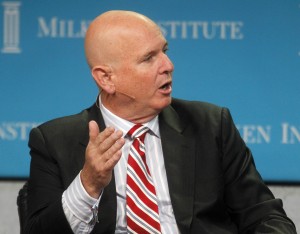
- CalSTRS exploring pros and cons of direct investments
- Setting up an external operating company in play
- CalSTRS’s PE program valued at $17.3 bln
California State Teachers’ Retirement System is examining the pros and cons of investing directly in private companies, rather than through traditional private equity funds and separate accounts.
An investment memo, included in the $215.3 billion retirement system’s Nov. 1 board materials, says CalSTRS will study and review direct-investment opportunities across the entire private markets platform, which includes real estate and infrastructure as well.
The review is designed “to identify the factors that go into deciding whether to change or augment our current investment strategies to a more direct or internal approach,” according to the memo.
The memo was written by CIO Christopher Ailman and Director of Real Estate Mike DiRe, whose program already oversees a small number of direct positions in companies.
“Over the course of the coming meetings, we will provide the Investment Committee with the pros and cons, costs, and risks of specific direct strategies,” the memo says.
Taking direct stakes in private companies would offer CalSTRS a number of advantages, including an ability to exert greater control over its assets and reducing the hefty fees paid to external private markets managers.
But scaling up its direct-investment program would also eat up the time of the retirement system’s staff, driving up internal costs. Direct investments also lead to a less diverse portfolio, which in turn drives up risk.
One of the options for pursuing direct deals involves setting up or acquiring an operating company, or some other external investment entity, the memo says.
“Investments in operating companies are the most complicated and difficult method of direct investing. It not only requires significant staff expertise and time, but it also requires the investor to adroitly balance company and asset goals and investments,” according to the memo.
The CalSTRS memo also notes opportunities to co-invest alongside general partners, a strategy in which the retirement system is already quite active.
Co-investments, which represent 5.4 percent of the $17.3 billion PE program’s total exposure, netted CalSTRS an 8.2 percent return since inception. CalSTRS co-invested $228 million in private equity deals in the first half of 2017, a recent investment report shows.
In July, CalSTRS staff proposed to overhaul part of its PE program to invest in more complex co-investment and secondary-market deals.
Director of Private Equity Margot Wirth and Portfolio Manager Rob Ross proposed setting up a separately managed account to give the retirement system access to larger deals, prior to when they’re syndicated to other investors.
The proposal would have also allowed staff to pursue secondary market holdings, including stakes in PE general partners. It’s unclear whether CalSTRS will ultimately execute on the latter strategy, which, in theory, could yield more opportunities for direct investments.
The retirement system did not respond to a request for comment.
Lower costs
CalSTRS, along with many public pensions, is confronting internal and external pressures to bring down the costs of its private equity portfolio — the most expensive asset class in its investment program.
Last year, CalSTRS paid $206 million of management fees to its PE managers, a cost report in November meeting materials shows. The system paid an additional $118 million in operating and other expenses.
Many large institutions are making an effort to bring down those costs through direct and co-investment strategies, which typically come with zero or significantly reduced external fees.
California’s other major public pension, the $337.8 billion California Public Employees’ Retirement System, has also explored new models for its PE program in recent months.
CalPERS staff and board members have discussed setting up an external entity to invest directly into companies, as well as handing off some of its portfolio to BlackRock or forming separate partnerships with other major institutions.
CalSTRS’s private equity program has returned 13 percent since inception, a recent investment report says. The program generated roughly $600 million of positive cash flows through the first two quarters of 2016.
Action Item: To access CalSTRS meeting materials, visit www.calstrs.com
Christopher Ailman, chief investment officer of California State Teachers Retirement System, speaks during a lunch panel, “Europe at a Crossroads,” at the Milken Institute Global Conference in Beverly Hills, California, on May 2, 2012. Photo courtesy Reuters/Fred Prouser


 If you do not receive this within five minutes, please try and sign in again. If the problem persists, please
email:
If you do not receive this within five minutes, please try and sign in again. If the problem persists, please
email: